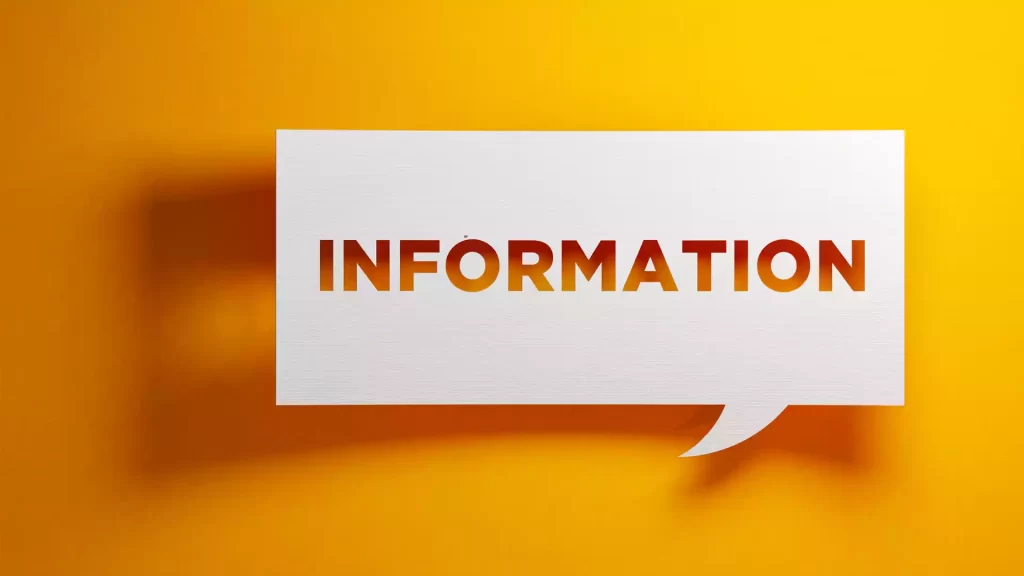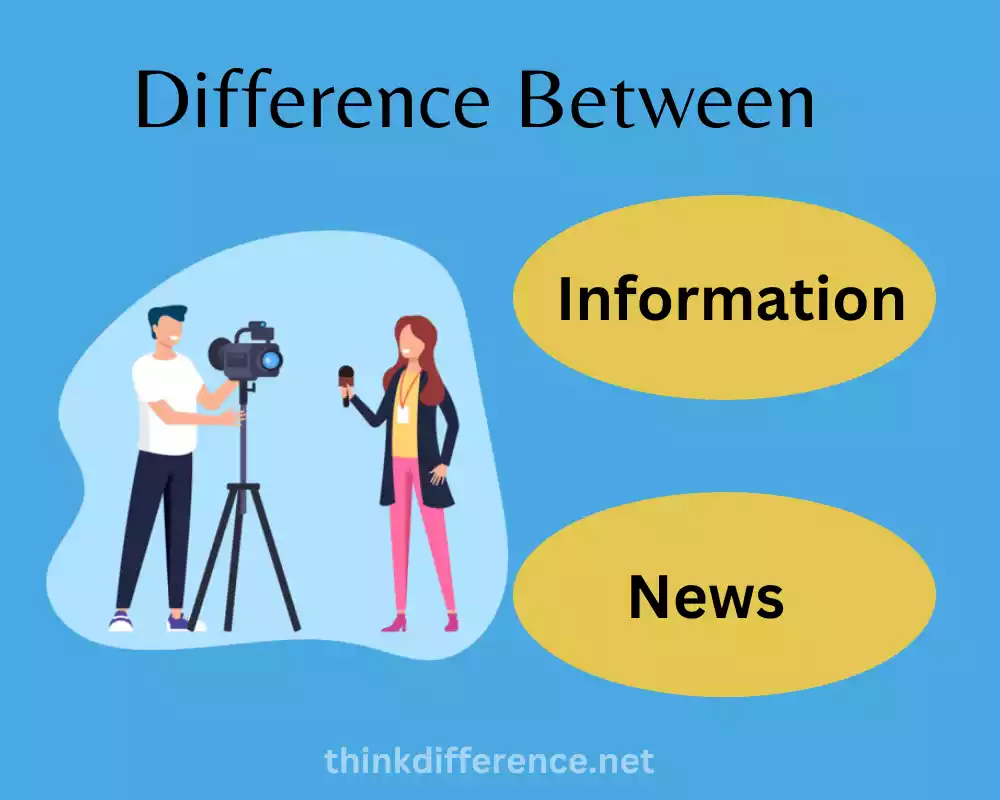News and Information are media to communicate information, facts, and information to educate and inform people. News refers to the timely and factual reports about the latest developments and news and news stories, written by professional journalists using diverse media channels. Its primary focus is on providing recent significant, verified, and important information that has an impact on society and helps people be well-informed and make informed choices.
However, information spans a greater range of information, which includes facts and data, as well as opinions as well as knowledge about various topics. Information is subjective as well as timeless and can come from a variety of sources, serving educational, instructive, or personal reasons.
It’s not just limited to current events and can be communicated by experts or non-experts via various mediums. The distinction between information and news is essential to media knowledge and informed decision-making in the current information-rich society.
Definition of News
News is a quick and accurate report or an account of events and developments relevant and of great interest to the general public. It is a crucial source of information regarding current events in the realms of politics, society and economics, culture, as well as other fields.

News is typically delivered by journalists trained to adhere to the highest standards of professional accuracy as well as objectivity and impartiality and ensure that the information is accurate and reliable. It is focused on providing information on significant events, typically in a way that is immediate and allows people to remain up-to-date with the world that surrounds their lives.
The primary goal for news media is keeping the general public current, allowing them to make informed choices, engage in discussions, and develop a knowledge of the intricate and constantly changing forces that influence our current world.
Definition of Information
Information is a broad concept that includes knowledge, data facts, information, and more which convey a broad range of concepts, topics, and knowledge. It’s the primary basis for understanding, allowing people to gain knowledge and understand everything around them.
Contrary to news, which generally refers to the current news, however, information is timeless and different in its source. It is available in articles, books or databases, discussions, and other sources that are written by scholars, experts, or people who share their own experiences.

Information plays a crucial part in research, education, and decision-making. It provides the base for societies to build their collective knowledge and advance. It may include guidelines, historical reports, scientific discoveries to the cultural heritage of a society, and more.
In today’s digital world information is now easier to access than it ever was before, aiding in the growth of human understanding as well as facilitating learning and communication globally. If you are looking for answers, pursuing new concepts, or expanding one’s knowledge information is essential to intellectual development and active participation in the connected world.
Importance of understanding the difference between News and Information
The difference between information and news is essential for a variety of reasons:
- Media Literacy: The ability to distinguish between news and information improves media literacy. It assists people in critically evaluating the information they are exposed to and distinguishing reliable news sources from unreliable or biased sources. This is crucial in the current climate of abundance of information and inaccurate information.
- Making informed decisions: Understanding the difference between news and information enables individuals to make informed choices. News offers information on the latest developments and topics, allowing individuals to remain informed about the latest developments in their lives and the communities they live in. Information, however, can provide a wider information base to help make the making of informed choices in different aspects of life like education, health, or individual interest.
- Beware of Misinformation: False information and disinformation are common occurrences in this digital age. Knowing the difference between news and information can help users identify false information and minimize the likelihood of being a victim of fake news or propaganda.
- Critical Thinking fosters critical thinking by encouraging people to investigate sources, confirm information, and judge the reliability of information and news outlets. This approach to critical thinking helps create educated and more informed citizens.
- Effective communication: Effective communication relies on the ability to communicate information with precision. Being aware of the different aspects of information and news helps individuals convey their ideas, thoughts, and conclusions more efficiently and responsibly.
- Personal Growth: Information can serve as an important source for personal development and ongoing learning. The recognition of this fact encourages people to search for different sources of information that can help them expand their understanding and perspectives.
- Community Engagement: Well-informed people tend to participate actively in their local communities, take part in civic events, and promote meaningful positive change. Knowing the latest news and information helps in fostering community involvement and social awareness.
Difference Between News and Information
Comparison chart for news and information:
| Characteristic | News | Information |
|---|---|---|
| Timeliness | Focuses on current events | Can be timeless |
| Objectivity | Strives for impartiality | Can be subjective |
| Relevance | Pertinent to recent happenings | Varied, subject-based |
| Source Variety | Relies on journalistic sources | Sources can be diverse |
| Purpose | Informs about current events | Serves various purposes |
| Audience | Broad, general readership | May target specific interests |
| Format | Brief and to the point | Can be more detailed |
Characteristics of News
- Timing: News is characterized by its relevance to current developments. It gives information on recent events and developments, highlighting the importance of staying up-to-date.
- Relevance: News focuses on issues that are important and relevant to a wide population, covering the issues that impact society, communities, or even individuals.
- Objectiveness: News reporting aims to be objective and fair by presenting information and facts free of personal bias or opinions to let readers make their judgments.
- Accuracy The news reports are based on verifiable facts and reliable sources. Journalists undergo fact-checking procedures to ensure that the information is accurate and reliable.
- Immediacy News is generally presented concisely directly and quickly, delivering essential information to accommodate the rapid nature of the news media.
- Conciseness news stories are short and focus on delivering essential information concisely and clearly, placing crucial information above irrelevant information.
- Impact: News stories cover topics and events that have a profound impact on society and help readers comprehend the effects of these changes.
Types of news
Here are brief explanations of the major kinds of news:
- Hard News: Current news and information on the latest developments.
- Soft News: Human interest, lifestyle and other entertainment-related stories.
- Local News: News coverage of events occurring in a specific region.
- National News: News that have national significance within a nation.
- International News: Issues and events from other countries.
- Business News: Updates on the economy and finances.
- Sports News: coverage of sporting events as well as athletes.
- Entertainment News: Industry news and celebrity gossip.
- Health News: Health and wellness news, medical breakthroughs.
- Science & Tech News Discoveries in science and technological breakthroughs.
- Environmental News: News about environmental issues.
- Political News: The political landscape is changing.
- Crime & Legal News criminal activities and legal instances.
- Human Interest News: Inspirational or unique stories.
- Opinion and Editorials: Journalists comment and write analysis.
Characteristics of Information
- Multi-faceted: Information can take a variety of forms, like facts, data, information or opinions and even insights. It can be used in a variety of situations and goals.
- Timelessness: unlike news, information isn’t dependent on a particular timeframe. It’s relevant and useful for long durations, which makes it last.
- Subjectivity: Information is subjective and affected by personal opinions as well as experiences, opinions, and experiences. It might not be impartial or objective, based on the source.
- Variety of sources: Information may come from a myriad of sources, such as academics, experts personal experiences as well as websites, articles, books and other media.
- Broad Spectrum: The information covers a broad range of topics, from instructional content to practical guidelines and historical documents, as well as the knowledge of cultures, as well as personal experiences.
- The practical value: Information can serve practical reasons, offering directions, guidance or information that people can apply to their activities, their jobs, or interests.
- Personal Relevance: The information can be personal-specific, adapted to the individual’s preferences and needs or even specific questions. It can be tailored to individual needs and goals for learning.
News and Information in the Future
Shortly the world of news and information is likely to undergo major changes driven by technological advances and shifting consumer habits. Digital platforms and media consumption on the internet will continue to grow in popularity and news and information being tailored to the individual’s preferences via AI-driven personalized.
Live updates and real-time reporting can be made possible by better connectivity, as well as citizens’ journalism and user-generated content will play a significant part when it comes to breaking news. However, the emergence of deepfake technology is likely to make it difficult to verify the authenticity of content and require better ways of confirming the authenticity of content.
Virtual and augmented reality technologies provide immersive news experiences and blockchain technology can increase the security and trust in the information source. The sustainable revenue models such as subscriptions will become more important, and address the issues that arise from ad-based models.
Education in media literacy will be vital as people attempt to navigate through a vast array of information. Additionally, ethical questions regarding personal information and privacy will become a central concern.
All in all, information and news will remain multi-dimensional, interactive, and created by artificial intelligence. This will require constant adaptation and an obligation to accuracy and authenticity.
What is the Relationship Between News and Information?
Information and news are closely connected concepts, sharing some similarities:
- Media for Communication: News and information are usually communicated via diverse communication media, including radio, newspapers, television books, online sources, and private conversations.
- Content Delivery: They are used to provide information, facts, and insight to individuals who want to know keep themselves informed, and make informed decisions.
- Digital accessibility: In the present digital world, information, and news are easily accessible online, which makes it easy for users to access them at any time and from any location.
- Educational value: News and information can be educative. They can provide individuals with opportunities to gain knowledge, expand their knowledge of the world, and participate in continuous learning.
- Subject matter: Though they could be a variety of topics News often includes informative elements and even contains news-related content. For example, an article in the news may give background information that can help improve comprehension.
- Information sources: They both depend on information sources that include journalists, experts, researchers or even people who share their own experiences. Reliable and trustworthy sources are crucial for both.
- The role of HTML0 in Decision-making: News and information play an important role in the process of making decisions. They aid individuals in making decisions based on their knowledge, whether it’s regarding current events (news) or more practical issues (information).
- Tools for communication: These two tools serve as tools for communication to share ideas, communicate knowledge and promote understanding between people and in the society.
Summary
Information is a broad concept comprising knowledge, data as well as facts and knowledge on a variety of subjects. It provides the basis to understand and is found in the form of books, articles or in conversations with sources that are presented by individuals or experts.
Contrary to news, which concentrates on the current news, information is a timeless resource and can have numerous applications in research, education as well as decision-making and solving problems. It can range from practical advice to historical reports as well as scientific discoveries and the rich cultural heritage.
In today’s digital world information is easily accessible which encourages global learning and communication. It’s the base for intellectual development and informed participation in our global network.

